Kimmeridgian
In the geologic timescale, the Kimmeridgian is an age or stage in the Late or Upper Jurassic epoch or series. It spans the time between 157.3 ± 1.0 Ma and 152.1 ± 0.9 Ma (million years ago). The Kimmeridgian follows the Oxfordian and precedes the Tithonian.[1]
| Kimmeridgian | |
|---|---|
| 1.0157.3 – 152.1 ± 0.9 Ma | |
| Chronology | |
Key events in the Jurassic -200 — – -195 — – -190 — – -185 — – -180 — – -175 — – -170 — – -165 — – -160 — – -155 — – -150 — – -145 — – how to approximate the timescale of key Jurassic events. Vertical axis: millions of years ago. | |
| Etymology | |
| Name formality | Formal |
| Usage information | |
| Celestial body | Earth |
| Regional usage | Global (ICS) |
| Time scale(s) used | ICS Time Scale |
| Definition | |
| Chronological unit | Age |
| Stratigraphic unit | Stage |
| Time span formality | Formal |
| Lower boundary definition | Not formally defined |
| Lower boundary definition candidates | FAD of the Ammonite Pictonia baylei |
| Lower boundary GSSP candidate section(s) | Flodigarry, Skye, Scotland, UK |
| Upper boundary definition | Not formally defined |
| Upper boundary definition candidates |
|
| Upper boundary GSSP candidate section(s) | |
Stratigraphic definition
The Kimmeridgian stage takes its name from the village of Kimmeridge on the Dorset coast, England. The name was introduced into the literature by French geologist Alcide d'Orbigny in 1842.[2] The Kimmeridge Clay Formation takes its name from the same type location. It is the source for about 95% of the petroleum in the North Sea.
Historically, the term Kimmeridgian has been used in two different ways. The base of the interval is the same but the top was defined by British stratigraphers as the base of the Portlandian (sensu anglico) whereas in France the top was defined as the base of the Tithonian (sensu gallico). The differences have not yet been fully resolved; As of 2004 Tithonian is the uppermost stage of the Jurassic in the timescale of the ICS.[3]
The base of the Kimmeridgian is at the first appearance of ammonite species Pictonia baylei in the stratigraphic column.[4] A global reference profile for the base (the GSSP of the Kimmeridgian stage) had in 2009 not yet been assigned. The top of the Kimmeridgian (the base of the Tithonian) is at the first appearance of ammonite species Hybonoticeras hybonotum. It also coincides with the top of magnetic anomaly M22An.[4]
Subdivision
The Kimmeridgian is sometimes subdivided into Upper and Lower substages. In the Tethys domain, the Kimmeridgian contains seven ammonite biozones:
- zone of Hybonoticeras beckeri
- zone of Aulacostephanus eudoxus
- zone of Aspidoceras acanthicum
- zone of Crussoliceras divisum
- zone of Ataxioceras hypselocyclum
- zone of Sutneria platynota
- zone of Idoceras planula
Palaeontology
Amphibians
| Amphibians of the Kimmeridgian | ||||
|---|---|---|---|---|
| Taxa | Presence | Location | Description | Images |
| Morrison Formation, Utah | An extinct genus of cryptobranchoid salamander. | |||
†Ankylosaurs
| Ankylosaurs of the Kimmeridgian | ||||
|---|---|---|---|---|
| Taxa | Presence | Location | Description | Images |
| Morrison Formation, Wyoming, USA | The smallest and the earliest well-known ankylosaur. Its skull measures only 29 cm in length, and its total body length is an estimated three to four meters. | 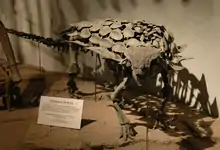 Gargoyleosaurus skeleton from Wyoming | ||
|
Morrison Formation, Colorado, USA | A poorly known early ankylosaurian. | ||
Birds
| Birds of the Kimmeridgian | ||||
|---|---|---|---|---|
| Taxa | Presence | Location | Description | Images |
|
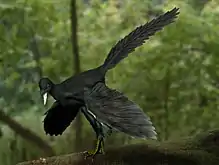 Life restoration of Archaeopteryx lithographica | |||
†Ornithopods
| Ornithopoda of the Kimmeridgian | ||||
|---|---|---|---|---|
| Taxa | Presence | Location | Description | Images |
| Kimmeridgian to Tithonian | Wyoming, USA | Camptosaurus could be more than 7.9 meters (26 feet) long, and 2.0 meters (6.6 feet) tall at the hips. It had heavy bodies but, as well as walking on four legs (quadrupedal), they could rear up to walk on two legs (bipedal). This genus is probably closely related to the ancestor of the later iguanodontid and hadrosaurid dinosaurs. It probably ate cycads with its parrot-like beak. |
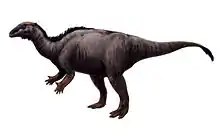 Camptosaurus  Othnielosaurus | |
†Plesiosaurs
| Plesiosaurs of the Kimmeridgian | ||||
|---|---|---|---|---|
| Taxa | Presence | Location | Description | Images |
 Liopleurodon | ||||
| Bajocian-Tithonian | ||||
†Sauropods
| †Sauropods of the Kimmeridgian | ||||
|---|---|---|---|---|
| Taxa | Presence | Location | Description | Images |
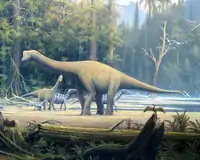 Europasaurus holgeri | ||||
|
||||
| Kimmeridge Clay Formation, England | ||||
| Morrison Formation, Colorado | ||||
| Kimmeridge Clay Formation, Dorset, England | The genus is preoccupied by a name Edward Drinker Cope coined in 1869. | |||
†Stegosaurs
| Stegosaurs of the Kimmeridgian | ||||
|---|---|---|---|---|
| Taxa | Presence | Location | Description | Images |
| England and France | A large stegosaurid |  Dacentrurus 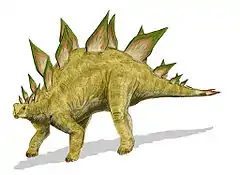 Stegosaurus | ||
| Upper Shaximiao Formation, Sichuan, China | Had relatively small dorsal plates and greatly enlarged shoulder spines, twice the length of the shoulder blades. Estimated to have been about 4 metres long. | |||
| Lourinhã Formation, Portugal | Closer to Dacentrurus than Stegosaurus. | |||
| *Hesperosaurus | Morrison Formation, Wyoming, USA | Had alternating plates on its back and four spikes on its tail. Appears more closely related to Dacentrurus than Stegosaurus. | ||
| Tanzania | A 4 meter long stegosaurian with spikes on its flanks. The length of the thigh bone compared with the rest of the leg indicates that Kentrosaurus was a slow and inactive dinosaur. | |||
| Loe-ein Formation, Tibet, China | The fragmentary condition of the only known skeleton places doubt on the validity of this genus | |||
| Kimmeridgian to Early Tithonian | Morrison Formation, Colorado, Utah, Wyoming, USA | Averaging around 9 metres (30 feet) long and 4 metres (13 feet) tall, the quadrupedal Stegosaurus is one of the most easily identifiable dinosaurs, due to the distinctive double row of kite-shaped plates rising vertically along its arched back and the two pairs of long spikes extending horizontally near the end of its tail. | ||
†Thalattosuchians
| Thalattosuchians of the Kimmeridgian | ||||
|---|---|---|---|---|
| Taxa | Presence | Location | Description | Images |
|
Germany | A relatively small metriorhynchid genus. |
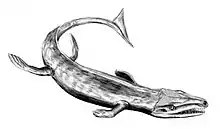 Dakosaurus, a marine crocodilian.  Metriorhynchus, a marine crocodilian. | |
|
Germany | A large metriorhynchid. The type species of the genus, Dakosaurus maximus, is known from Western Europe (England, France, Switzerland and Germany) of the Late Jurassic (Late Kimmeridgian-Early Tithonian). | ||
|
|
Machimosaurus hugii was the largest named teleosaurid and thalattosuchian up to its time, with an estimated length of approximately 7.2 metres | ||
|
Sabinal Formation, Tlaxiaco Basin, Oaxaca, Mexico | A metriorhynchid. It is the most basal genus of the Rhacheosaurini Tribe. | ||
|
England, France and Switzerland | An opportunistic carnivore that fed on fish, belemnites and other marine animals and possible carrion. Metriorhynchus grew to an average adult length of 3 meters (9.8 feet). | ||
|
Kimmeridge Clay Formation, Wiltshire, England; Oaxaca, Mexico | |||
†Theropods (non-avian)
| †Non-avian theropods of the Kimmeridgian | ||||
|---|---|---|---|---|
| Taxa | Presence | Location | Description | Images |
 Allosaurus 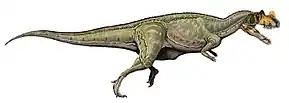 Ceratosaurus  Coelurus  Elaphrosaurus  Lourinhanosaurus  Marshosaurus  Ornitholestes  Tanycolagreus  Torvosaurus | ||||
|
Guimarota Mine, Portugal | Small 5 kg tyrannosauroid. Aviatyrannis along with Stokesosaurus represents the oldest known tyrannosauroids. | ||
|
Morrison Formation, Wyoming | Small theropod about 2 metres in length | ||
|
Tendaguru Beds, Tanzania | Probably a ceratosaur about 6 meters long | ||
|
Morrison Formation, Wyoming | Probably a ceratosaur. | ||
|
Lourinhã Formation, Portugal | A genus of medium sized carnivorous theropod dinosaurs. A basal tetanuran, might be an allosauroid, megalosauroid or a coelurosaur. | ||
|
Cleveland-Lloyd Quarry, Brushy Basin Member, Morrison Formation, Utah and possibly Colorado | |||
|
Bone Cabin Quarry, Morrison Formation, Wyoming | Ornitholestes hermanni is a species of basal coelurosaurian theropod. | ||
|
Morrison Formation, Oklahoma | Possibly a species of Allosaurus but larger and much rarer than Allosaurus' type species. Estimated from 10.5 to 13 meters in length and from 3 to 4.5 metric tons in weight it's potentially the largest terrestrial predator of the Jurassic. | ||
|
Morrison Formation, Wyoming | Tanycolagreus is a genus of basal coelurosaurian theropod. | ||
|
|
Torvosaurus was a very large megalosaurid predator, with an estimated maximum body length of 10 m (33 ft) and mass of 3.6–4.5 tonnes (4–5 short tons) for both its species, making Torvosaurus among the largest land carnivores of the Jurassic. Thomas Holtz estimated it at 12 meters (39 feet). Claims have been made indicating even larger sizes. | ||
Nautiloids
| Nautiloids of the Kimmeridgian | ||||
|---|---|---|---|---|
| Taxa | Presence | Location | Description | Images |
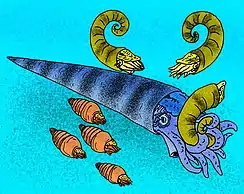 An illustration of a variety of fossil nautiloids. | ||||
†Ammonites
| Ammonites of the Kimmeridgian | ||||
|---|---|---|---|---|
| Taxa | Presence | Location | Description | Images |
|
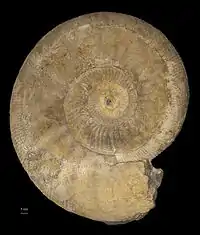 Lithacosphinctes achilles. | |||
†Belemnites
| Belemnites of the Kimmeridgian | ||||
|---|---|---|---|---|
| Taxa | Presence | Location | Description | Images |
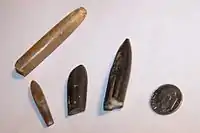 Small belemnite fossils | ||||
Palaeontological sites
References
Notes
- "Global Boundary Stratotype Section and Point". International Commission of Stratigraphy. Retrieved 23 December 2020.
- Gradstein, F.M.; Ogg, J.G.; Schmitz, M.D.; Ogg, G.M. (editors) (2012). The Geologic Timescale 2012 (volume 1). Elsevier. p. 745. ISBN 978-0-44-459390-0.CS1 maint: uses authors parameter (link)
- INTERNATIONAL SUBCOMMISSION ON JURASSIC STRATIGRAPHY, Newsletter 31, Edited by Nicol Morton and Paul Bown, August 2004
- "Global Boundary Stratotype Section and Point (GSSP) of the International Commission on Stratigraphy". GSSP Table - All Periods. International Commission on Stratigraphy. Retrieved 5 January 2018.
- Mateus, Octávio; Hendrickx, Christophe (5 March 2014). "Torvosaurus gurneyi n. sp., the Largest Terrestrial Predator from Europe, and a Proposed Terminology of the Maxilla Anatomy in Nonavian Theropods". PLOS ONE. 9 (3): e88905. doi:10.1371/journal.pone.0088905. ISSN 1932-6203. PMC 3943790. PMID 24598585.
Literature
- Gradstein, F.M.; Ogg, J.G. & Smith, A.G.; 2004: A Geologic Time Scale 2004, Cambridge University Press.
- Thurmann, J.; 1832: Sur Les Soulèvemens Jurassiques Du Porrentruy: Description Géognostique de la Série Jurassique et Théorie Orographique du Soulèvement, Mémoires de la Société d'histoire naturelle de Strasbourg 1: pp 1–84, F. G. Levrault, Paris.(in French)
External links
- GeoWhen Database - Kimmeridgian
- Jurassic-Cretaceous timescale, at the website of the subcommission for stratigraphic information of the ICS
- Stratigraphic chart of the Upper Jurassic, at the website of Norges Network of offshore records of geology and stratigraphy